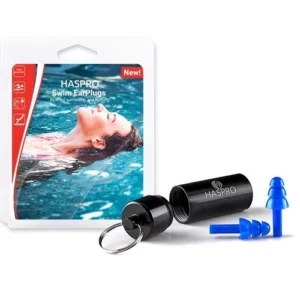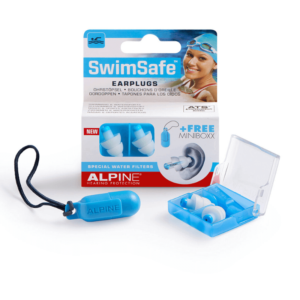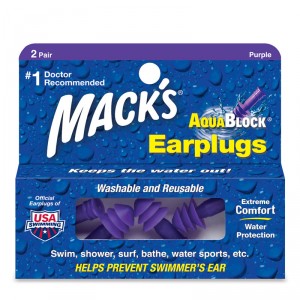Now that the good weather has finally arrived, many of us are going to the pool or sea in order to cool down. However, with water sports comes an increase in swimmer’s ear.
What Is Swimmer’s Ear?
Swimmer’s ear is an infection found in the outer ear canal. This can be defined as an area that extends from the outer ear (pinna) to the eardrum (tympanic membrane). The official, medical name for swimmers ear is otitis externa. When moisture gets caught in the outer ear space, this creates a perfect breeding ground for bacterial growth. This bacteria can then enter the skin of the ear canal and result in swimmer’s ear.
Moisture in the ear is the main culprit when it comes to Swimmer’s Ear. Debris can also be retained in the ear after swimming can cause this problem. However it is not just swimming. Showering and bathing can also cause it. In fact, any moist environment can be a source of retained moisture.
Swimmer’s ear should be treated as soon as it becomes a problem in order to protect your hearing and to prevent further infection.
Understanding the Ear’s Natural Defences
While we’ve discussed how to protect your ears externally, it’s fascinating to understand how your ears naturally defend themselves against infections:
- Cerumen (earwax) production: Your ears produce this waxy substance as a natural barrier against water and bacteria. It’s slightly acidic, which helps prevent bacterial growth.
- Ear canal shape: The slight downward slope of your ear canal naturally helps water drain out.
- Epithelial migration: Your ear canal has a self-cleaning mechanism where skin cells gradually move outward, carrying debris with them.
- Immune response: Your ear canal contains immune cells ready to fight off invading bacteria.
However, frequent exposure to water can overwhelm these natural defences. That’s why swimmers need to take extra precautions, like using earplugs and drying their ears thoroughly after water activities.
Understanding these natural mechanisms can help you appreciate why certain prevention methods are effective and why it’s crucial not to interfere with your ears’ natural processes (like by over-cleaning with cotton buds).
What Else Can Cause Swimmer’s Ear?
Some extra causes of Swimmer’s Ear can include:
- Exposure to bacteria from polluted water or hot tubs
- Frequent cleaning of the ear canal with cotton buds
- Eczema or seborrhea, which can cause cuts in the ear canal for bacteria to get in
- Hairspray or hair dye that has entered the ear canal
What Symptoms Do you Get with Swimmer’s Ear?
The most common symptom of swimmer’s ear is intense itching of the outer ear canal. This itching may be accompanied by a waxy drainage from the ear, or a dry feeling. It is important to note that swimmer’s ear does not usually cause a fever.
Another symptom of swimmer’s ear is pain. The pain is usually more intense when pulling on the affected ear or when pressure is applied to it. This can happen even during normal activities such as talking or chewing.
There may also be redness, swelling and tenderness in the ear canal or along the outer ear, indicating an infection. In some cases, the outer ear may also become hardened and difficult to move.
It is important to seek medical advice if any of these symptoms occur, as swimmer’s ear can lead to hearing loss and other complications if left untreated. If a doctor suspects swimmer’s ear, they may conduct a physical exam to determine the severity of the infection, and may prescribe antibiotics or antiviral medications, or recommend over-the-counter remedies.
By recognising the symptoms of swimmer’s ear and seeking prompt medical treatment, the infection can be treated quickly and effectively.
Severe Cases of Swimmer’ Ear
In extreme cases, the following symptoms can occur:
- Temperature or Fever
- Reduced hearing
- Pain that is intense and can spread to face, head or neck
- Swelling and redness of the skin around the ear
- Discharge that has an odour
Generally, you should not be concerned if you have Swimmer’s Ear. It is a condition that can be cleared up quickly once treated. Left untreated though and it can be a real danger, especially for elderly people, those with immune system problems, or people with diabetes.
Can Swimmer’s Ear Cause Complications?
Yes, if it is not treated. Problems can include
- Hearing loss
- Ear infections that recur (chronic otitis externa)
- Cartilage or bone damage
How Do You Treat Swimmer’s Ear?
A doctor should take a look if you have swimmer’s ear. That person will carry out an otoscopic examination to ensure that there is no eardrum perforation and risk of moisture entering the middle ear. Your doctor should be able to clean the infected area to reduce the pain and irritation. Antibiotic ear drops will then need to be taken to stop the infection. During the healing process it is important that the infected ears are kept dry.
How to Avoid Getting Swimmer’s Ear
- If you don’t want to get Swimmer’s Ear, there are some simple measures you can take to protect yourself.
- When you have been in the water, dry your ears. Let your head tip to one side and allow the water to drain out. Do this for both ears. Cotton buds should never be used for this. Instead use a tissue or dry towel.
- Stop water from getting in the ear by wearing earplugs. We have a wide selection of earplugs for swimming, manufactured by leading brands such as Mack’s, Speedo and Zoggs.
- Keep proper earwax hygiene. The outside of the the ear canal is protected by your earwax. Too much or too little can be cause a problem. Avoid using cotton buds to clean the ears as they can cause ear canal damage and this can lead to infection.
- Keep your skin healthy. The skin inside of your ear canal protects and prevents infection.
Health conditions that cause dry or cracked skin can open you up to the risk of infection. - Don’t let chemicals enter your ear. If you must use hairspray or hair dye, protect the entrance of your ear with your hands or by using earplugs.
- Use ear drops. Some over-the-counter medicines to prevent swimmer’s ear do exist. Ear drops can can be bought that will protect your ears from trapped water.
Whilst it is important to be on the lookout for symptoms of Swimmer’s Ear. However, there’s no reason it should prevent you from taking to the water and enjoying the summer!
Earplugs We Recommend To Prevent Swimmer’s Ear
Using earplugs while swimming can help prevent swimmer’s ear by keeping water out of the ears. Let’s examine some of the top earplug options for swimmers and how they can protect against this painful condition.
Alpine Swimsafe Earplugs
Alpine Swimsafe earplugs are designed specifically for swimming and water protection. They feature a tapered, ribbed stem that allows for an easy, comfortable fit and a secure seal to keep water out. The material is soft, hypoallergenic silicone that moulds to the unique contours of each ear canal. Alpine Swimsafe earplugs have a noise reduction rating of 22 decibels, meaning they block sound and prevent water from entering while still allowing you to hear voices and signals while swimming. Users report that they are easy to insert and remove, provide a watertight seal, and stay in place even during rigorous swimming and diving. By keeping the ears dry, Alpine Swimsafe earplugs can prevent the moisture buildup that allows infection-causing bacteria to take hold.
Haspro Swim Earplugs for Swimming

Haspro swim earplugs are made of antibacterial silicone and feature a three-ridge, ergonomic design to create a tight seal that keeps water out of the ears. They are reusable, easy to clean after swimming, and provide noise reduction while allowing you to still hear what you need to during water activities. The smooth, bevelled edges make insertion comfortable and hassle-free. Haspro swim earplugs are designed to form a custom, snug fit for each wearer, adapting to the shape of the ear canal to block water even during strong waves or deep diving. By preventing water from penetrating the ear, Haspro earplugs can stop swimmer’s ear before it starts. Users praise their comfort and effectiveness at keeping ears dry.
Mack’s AquaBlock Earplugs
Mack’s AquaBlock earplugs are specifically designed for water protection and feature a sealed dome tip that fits securely in the ear canal to form a waterproof barrier. The mouldable silicone putty on these earplugs allows them to conform to each person’s ear shape for a tight custom fit. The stem helps make insertion smooth and easy. Mack’s AquaBlock earplugs have a noise reduction rating of 22 decibels, meaning you can still hear moderately loud sounds while wearing them. The length of the stem and angle of the plug enhance comfort and wearability. By completely blocking water from entering the ear, Mack’s AquaBlock earplugs can prevent the moisture buildup that leads to painful swimmer’s ear infections. Users report excellent water blocking ability and comfort with these earplugs.
Ohropax Silicon Aqua Earplugs
Ohropax Silicon Aqua earplugs feature durable, medical grade silicone designed for water protection and comfort. With a tapered shape and ridge edges, they are easy to insert correctly for a tight, secure fit that keeps water out of the ears during swimming and bathing. Ohropax earplugs have an estimated 12 decibel noise reduction rating to muffle exterior sounds while still allowing you to hear voices, music, and other important noises at moderate volumes. The translucent silicone allows visualisation of the ear canal during fitting. By sealing out water, Ohropax Silicon Aqua earplugs can prevent swimmer’s ear by keeping the ear canals dry. Users praise the softness and durability of these silicone earplugs.
In summary, earplugs designed specifically for swimming and water protection can go a long way towards preventing painful swimmer’s ear infections. By keeping water out of the ears, quality earplugs like Alpine Swimsafe, Haspro, Mack’s AquaBlock, and Ohropax Silicon Aqua can stop moisture buildup and bacteria growth before they have a chance to cause problems. The tapered, ergonomic shapes, mouldable materials, and snug seals of these earplugs allow them to create a waterproof barrier while remaining comfortable during extended wear. If you participate frequently in water sports, investing in a pair of swim earplugs can help you avoid the annoying symptoms of swimmer’s ear.
Photo by Anthony Cunningham for Zoom Health
Zoom Health is a leading UK supplier of Home Health Tests and Earplugs







